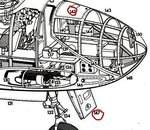Navigation
Install the app
How to install the app on iOS
Follow along with the video below to see how to install our site as a web app on your home screen.
Note: This feature may not be available in some browsers.
More options
You are using an out of date browser. It may not display this or other websites correctly.
You should upgrade or use an alternative browser.
You should upgrade or use an alternative browser.
A-20 bombardier
- Thread starter Maxrobot1
- Start date
Ad: This forum contains affiliate links to products on Amazon and eBay. More information in Terms and rules
More options
Who Replied?FLYBOYJ
"THE GREAT GAZOO"
Airframes
Benevolens Magister
The rear gunner(s)/radio op boarded and exited via a pull-down step on the post side, and kick-in steps on the fuselage, through the rear canopy, the rear section of which slid forward, under the fixed glazing. This assembly hinged to starboard for emergency exit on the ground. However, in flight, the rear gunner was the last to exit, in an emergency, over the side, possibly the only aircraft where the captain was not last to leave. This was beacause the pilot had to jettison the canopy roof, climb out onto the wing, and slide off the trailing edge, port side.
The rear compartment was fitted with basic stick and rudder pedals, in order that the gunner could hold the aircraft steady whilst the pilot bailed out.
Those later models fitted with a powered top turret still had the basic controls, but I believe exit in the air was via the tunnel-gun hatch in the rear belly.
The rear compartment was fitted with basic stick and rudder pedals, in order that the gunner could hold the aircraft steady whilst the pilot bailed out.
Those later models fitted with a powered top turret still had the basic controls, but I believe exit in the air was via the tunnel-gun hatch in the rear belly.
- Thread starter
- #4
Thanks for the replies!
I always thought that the A-20 pilot had a tricky job climbing up onto the fuselage, opening the long hatch/canopy section and climbing in! That must have been a task in the rain, wearing flight gear and a parachute. I didn't know the rear gunner had to be as athletic too!!
Years ago in NY there was a radio personality on WOR AM who had a crippled foot from when he was a B-29 crewman in WWII. Gene Klaven exited via the crew door in the tail section and the little ladder collapsed causing him to fall and be injured.
Sometimes exiting a plane on the ground can be dangerous too.
I always thought that the A-20 pilot had a tricky job climbing up onto the fuselage, opening the long hatch/canopy section and climbing in! That must have been a task in the rain, wearing flight gear and a parachute. I didn't know the rear gunner had to be as athletic too!!
Years ago in NY there was a radio personality on WOR AM who had a crippled foot from when he was a B-29 crewman in WWII. Gene Klaven exited via the crew door in the tail section and the little ladder collapsed causing him to fall and be injured.
Sometimes exiting a plane on the ground can be dangerous too.
Last edited:
Airframes
Benevolens Magister
Don't I know it! Got a really nasty crack on the head when climbing out of a Canberra once. I forgot about the hatch door, which hinges upward!!
- Thread starter
- #6
Sometimes I look at the P-38 lightnings with the glass nose and shudder thinking how uncomfortable it must have been on a mission up there.
The P-38 was notorious for having a cold pilots compartment. What about the poor guy in the nose?
And how would he get out in an emergency?
The P-38 was notorious for having a cold pilots compartment. What about the poor guy in the nose?
And how would he get out in an emergency?
Users who are viewing this thread
Total: 1 (members: 0, guests: 1)


